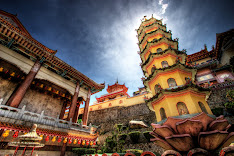Flash It!
Posted by Kenny in Published Article on Monday, September 6, 2004
This time we look at one of the most useful feature you have on your camera, the flash. Surprisingly we almost always take this feature for granted, thinking that all there is to it is to switch it on and off whenever we need it or don’t. Well, this month, I’ll share some tips with you on how you can effectively use your flash.
Most of us would have the standard flash unit built-in on our (digital) camera. Of course if you have moved on to a prosumer (digital) SLR camera, then you may already know about the different ways of using an external flash. This set-up gives you the versatility of using bounce flash and a more powerful flash output. But this month we’ll focus on the compact digicam.
Understanding Your Camera’s Built-in Flash
We are most familiar with the usage of flash at times when there is not enough light to take a good picture. Set on Auto, your camera would compensate by adjusting shutter speed and aperture to light up and give you the best exposure for your subject. It is also the most portable lighting equipment that you will ever have.
On a standard camera, your flash unit has 4 settings, namely “On”, “Off”, “Auto” and “No Red-Eye”. “On” and “Off” is quite obvious, allowing you manual control in switching the flash on and off. “Auto” setting lets your camera choose to activate the flash depending on lighting conditions. The “No Red-Eye” setting prevents red-eye effect on your subject caused by the flash illuminating the blood vessels at the back of the eye and bouncing it back to the lens. Almost all cameras do this by activating an initial flash which shrinks your subject’s pupils before taking the actual shot.
Let There be Light
Okay, on with the tips. Here are a list of things you would use your flash for apart from just illuminating the scene.
1) Light up shadows
One of the most useful times to use flash is when natural light is at its brightest. This is when harsh shadows are created on your subject. Because of the amount of light, your camera would not automatically switch on your flash; therefore you would have to do it manually. The resulting flash will light up the shadow areas on your subject giving you a more balanced shot.
2) Put a sparkle in her eyes
Sometimes even when natural light is enough, consider using the flash to give a sparkle in your subject’s eyes. This also lights up your subject’s face resulting in a livelier look.
When you are taking a picture of your subject against a night scene with the normal flash setting, you would probably end up with your subject brightly exposed by your flash and little else of the background. Most new digicam have “Night-Scene/Mode” setting on them. This means the camera uses flash along with a slow shutter speed. Use this to illuminate your subject and at the same time enough lighting from the scene will be captured by your camera.
Using your flash is also a great way to freeze motion. What happens when you are faced with low lighting condition and you have a moving object to capture? Use your flash for a burst of light to freeze your subject. Your shot is then less likely to result in blurring. You could even try using “Night-Scene/Mode” and panning (using your camera’s viewfinder to track your subject) to create nice effect. This allows you to capture your subject sharp against a motion-blurred background.
5) Improve contrast and saturating colours
Low ambient lighting results in poorly lit low contrast images. Use your flash to improve the contrast level of the object you are shooting. This also brightens and increases the colour saturation of your picture. You will have to trigger your flash manually to do this.
When Not to Use Your Flash
Okay, in getting to know when to use your flash, you should also know when not to use it.
1) When your subject is out of range
Most built-in flash have an effective range of approximately up to 10ft or 3m. If your subject is standing beyond this range, either move closer to your subject or switch off your flash and use a slower shutter speed setting. On your digicam you can also use a higher ISO setting to capture your subject at a higher shutter speed.
2) When you are taking a pleasant and usually warm ambience.
If you want to effectively take the pleasant nature of a scene that is lit by warm lighting such as candle light, don’t use flash if it is possible. However, make sure you have enough ambient lighting to prevent underexposure or blurring due to movements. A tripod is best used here.
3) When you are shooting a reflective surface
Shooting with the flash on and directly in front of a reflective object is a sure way of ruining your picture. This includes shooting through a window or between metal bars or fencing. The reflection from your flash will bounce off the shiny surface and right back to the lens resulting in a blurred highlight. If you have no other choice, try shooting from an angle to avoid reflections.
4) No flash photography allowed
Some places like museums, art gallery, or specialty zoos do not allow flash photography. Here using a slower shutter speed coupled with a tripod or simply switch your camera to a higher ISO setting.
Personally, I almost always keep my flash on. The added highlight created by the flash on my subject is a good ingredient in creating a brighter and livelier shot. Practice on having a good eye on observing lighting conditions around you. Eventually you will be able to predict how your flash will work in different conditions without having to do a double-take. So, go ahead, flash it!

